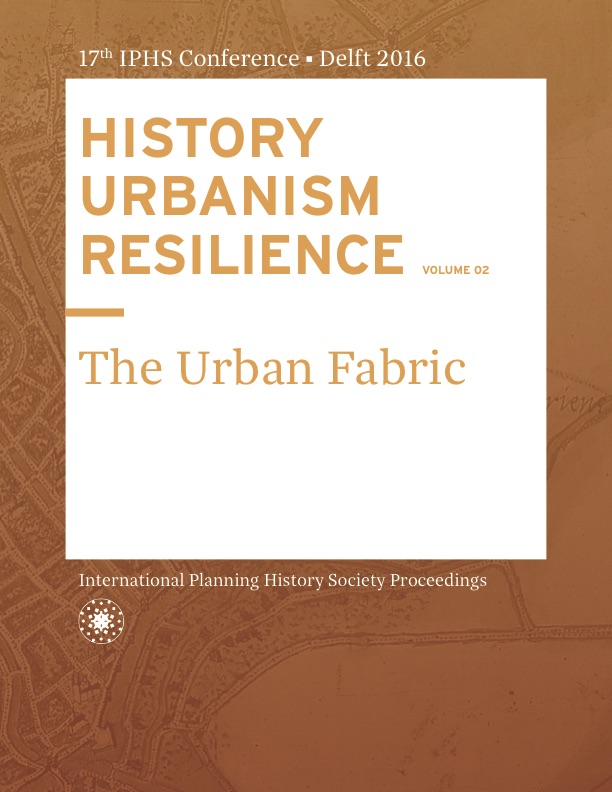Assimilation of the Industrial Village concept by Japanese business circles at the turn of the 20th Century
DOI:
https://doi.org/10.7480/iphs.2016.2.1248Abstract
This study demonstrates the significance of a broader investigation into the assimilation of planning practices and concepts of western industrial villages by Japanese business circles. An early albeit lone example, is a 2016 introduction by Yorifusa Ishida describing Magosaburō Ohara’s achievement - a trial to develop an industrial village, and basic research on social reform - at the Kurashiki Bouseki Co Ltd. In addition, studies examining how Japanese academics, officials, and administrators, adopted the garden city idea primarily stem from their understanding of the writings of Ebenezer Howard (eg Watanabe, Katagi et al). However, few studies have examined Japanese business circles’ understanding of industrial villages as a broader basis for the Japanese adoption of garden city principles.In addition to schools of architecture, Japanese institutions of higher education such as schools of economics, agriculture, and law, collected books on western industrial villages. In general, schools of agriculture and economics had larger collections of books than schools of engineering, indicating that the idea of industrial villages, including the garden city, was accepted and taught in various contexts. Further, graduates in various fields of business could have recognized these ideas. Tokiyoshi Yokoi (1890-1927) introduced the idea of the garden city to Ohara. He taught at the Tokyo Imperial University School of Agriculture which collected books on the garden city movement. Hajime Seki (1873-1935), of the Tokyo College of Commerce, investigated the garden city concept when drafting the Kōjō Hō (the Manufacturing Act of 1911). His pupil, Masayoshi Tasaki (1880-1976), translated and introduced The Garden City Movement (1905) by G. M. Harris (with a preface by Howard) in 1917. Later, he proposed the development of a garden city for workers to the Mitsubishi Shipbuilding Co Ltd.
By analysing an existing compendium of Japanese overseas travelers in the late 19th and the early 20th century, we can attain a thorough understanding of their experiences in the western industrialised environment. Business travel increased rapidly in the 1890s and by 1910 one-third of total overseas travel was attributable to business. These trips enabled Japanese businesses to assimilate concepts and practical information regarding western industrial villages. The Nikkō Electric Copper Smelting Co Ltd sent its core administrators to western countries. Manager Tsunesaburō Suzuki (1873-1940) traveled to Bournville in the United Kingdom in 1911 to meet George Cadbury and received advice about industrial management. Returning to Japan, he reformed his factory according to the principles of Onjō-Shugi (closely translated as Paternalism). In 1915, Manager Tetsutarō Hasegawa (1884- ?) wrote about Krupp’s welfare facilities and housing supply in Essen, Germany.
The concept of western industrial villages was considered a means of business administration in Japanese business circles. Current evidence indicates that the primary transmission of the concept was related to planning; however, we argue that it emerged first in the rural industries of Japan.
References
Doi, Teppei. ‘Onjō-Shugi to Seiyō no Setten’ [Contact Point Between ‘Paternalism’ and the West]. Bulletin of Archiving Center for Coal Studies of Kyushu University, Fukuoka (March 2004): 109–139.
Enoki, Kazue. ‘Paternalism of Modern Japanese Management’. Journal of Ohara Institute for Social Research (2009): 611–612. 28–42.
Furukawa Electric Industry Co. Nikkō Electric Copper Smelting Plant. Seidōshō Goju-nen [Fifty Years of the Copper Smelting Plant]. Tokyo: Furukawa Electric Industry Co. and Nikkō Electric Smelting Plant, 1954.
Furukawa Electric Industry Co. Sōgyō Hyakunen Shi [Centennial History of Enterprise]. Tokyo: Furukawa Electric Industry Co., 1991.
Furukawa Mining Co. Sōgyō Hyakunen Shi [Centennial History of Enterprise]. Tokyo: Furukawa Mining Co., 1976.
Hasegawa, Tetsutarō. Kōjō to Shokukō [Factory and Workers]. Tokyo: Shuei-sha, 1915.
Hein, Carola. ‘The Transformation of Planning Ideas in Japan and its Colonies’. In Urbanism: Imported or Exported? edited by J. Nasr and M. Volait, 51–82. Chichester: John Wiley & Sons, 2003.
Hirai, Naoki, Jun-ichiro Ishida and Shigeyasu Ikegami. ‘The Contemporary Evaluation of Workers’ Dormitories in the Early 20th Century: A Historical Examination of Workers’ Dwellings Based on the Writings of Riemon Uno–Part 1’. Journal of Architecture and Planning AIJ 78 (689) (2013): 1621–30.
Ishida, Yorifusa. ‘Japanese Industrial Villages and a Reformist Factory Owner’. Planning Perspectives 5 (3) (1990): 295–305.
Katagi, Atsushi, Youetsu Fujiya, and Yukihiro Kadono, eds. Kindai Nihon no Kougai Jutaku-chi [The Suburban Residental Developments in Modern Japan]. Tokyo: Kajima Shuppan-kai, 2000.
Okada, Hanna, Junne Kikata, and Yusuke Koyama. ‘On the Theoritical Background of the Industrial Town Development of Nikkō Copper Refinery’. AIJ Kyushu Chapter Architectural Research Meeting, Naha, Architectural Institute of Japan 55 (March 2016): 25–32.
Shataku Kenkyu-kai, ed. Shataku Gai—Kigyō no Unda Jutakuchi [Company Housing Districts–Residential Developments by Private Companies]. Tokyo: Gakugei Shuppan-sha, 2009.
Sorensen, André. ‘Urban Planning and Civil Society in Japan: Japanese Urban Planning Development During “Taisho Democracy” Period’, Planning Perspectives 16 (4) (2001): 383–406
Suzuki, Tsunesaburō. Rōdō Mondai to Onjō-Shugi [Labour Problems and Paternalism]. Tokyo: Yōriki-sha, 1915.
Suzuki, Tsunesaburō. Kōjō Kanri Jitsugaku [Practical Science of Factory Management]. Tokyo: Daiyamondo-sh, 1919.
Tezuka, Akira and Ishijima, Toshio. Bakumatsu-Meiji Kaigai Tokōsha Junbutu Jōhō Jiten [Compendium of the Overseas Travellers in the Last days of the Tokugawa-Shogunate and Meiji Era]. Tokyo: Genshō-sha, 2003.
Tsutsui, William. Manufacturing Ideology: Scientific Management in Twentieth-Century Japan. Princeton: Princeton University Press, 1998.
Uno, Riemon. Kōjō Nikkō Denki Seidōsho [A Model Factory–Nikkō Electric Copper Smelting Co.]. Tokyo: Kōgyō Kyōiku Kai, 1914.Ward, Stephen V. ‘Re-examining the International Diffusion of Planning’, In Urban Planning in a Changing World–The Twentieth Century Experience, edited by Robert Freestone, 40–60. London: Spon, 2000.
Watanabe, Shun-ichi. The Birth of Urban Planning–Japan’s Modern Urban Planning in International Comparison. Tokyo: Kashiwa Shobo, 1993.
Yamaguchi, Hiroshi, ed. Kōgai Jutakuchi no Keifu [Genealogy of Suburban Residental Developments]. Tokyo: Kajima Shuppan-kai, 1984.
Yokokawa, Haruka and Ken Nakae. ‘A Study on Book Collections About Garden City at Higher Education Institutions and Academics’ Understanding of Them–Adoption Process of Garden City Ideas in the Meiji and Taisho Periods in Japan’. Proceedings of the Housing Studies Symposium 2015, Tokyo: Architectural Institute of Japan (December 2015): 25–32.

